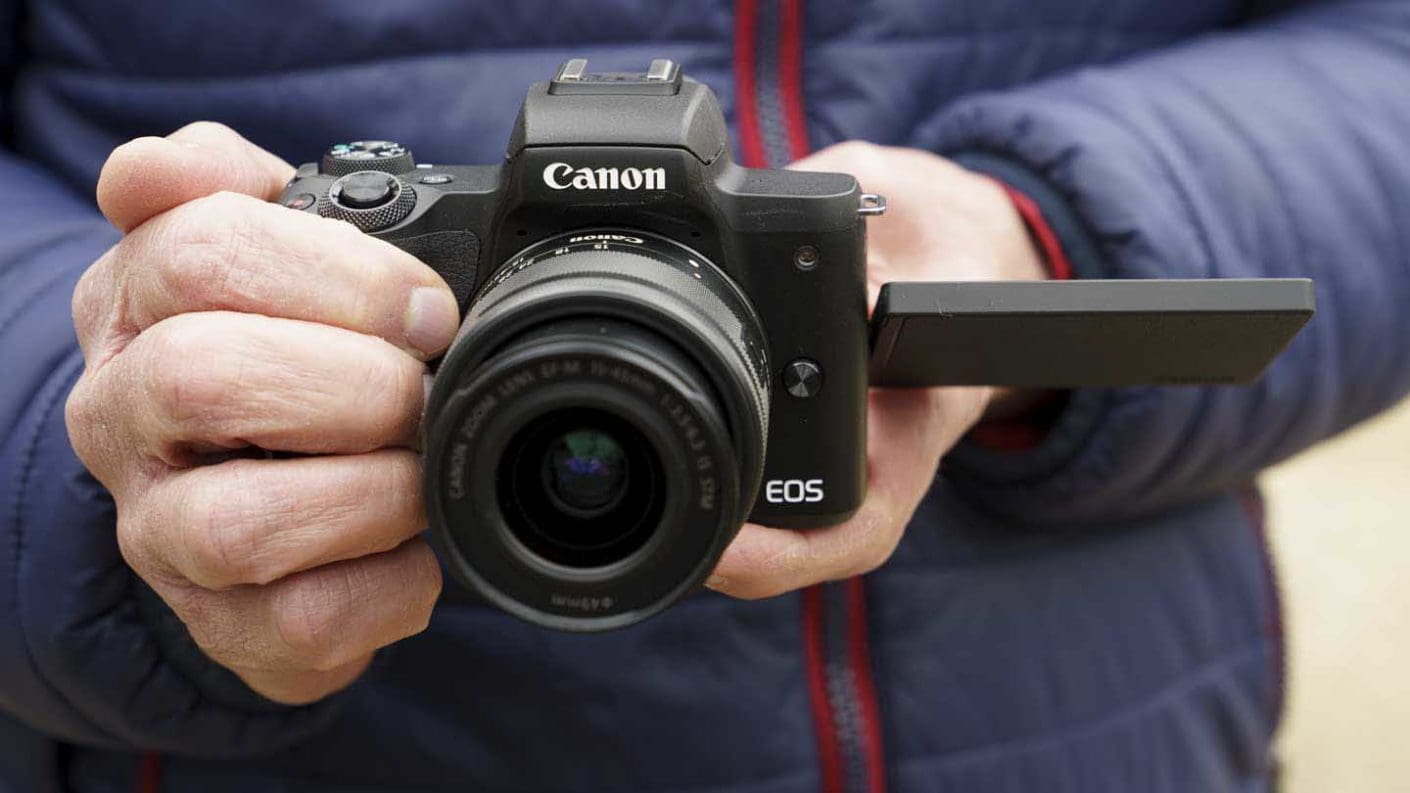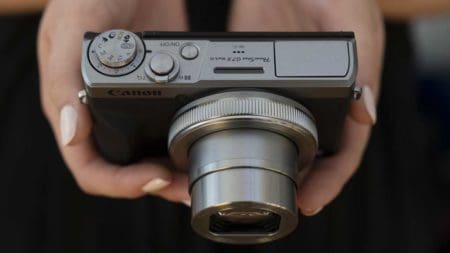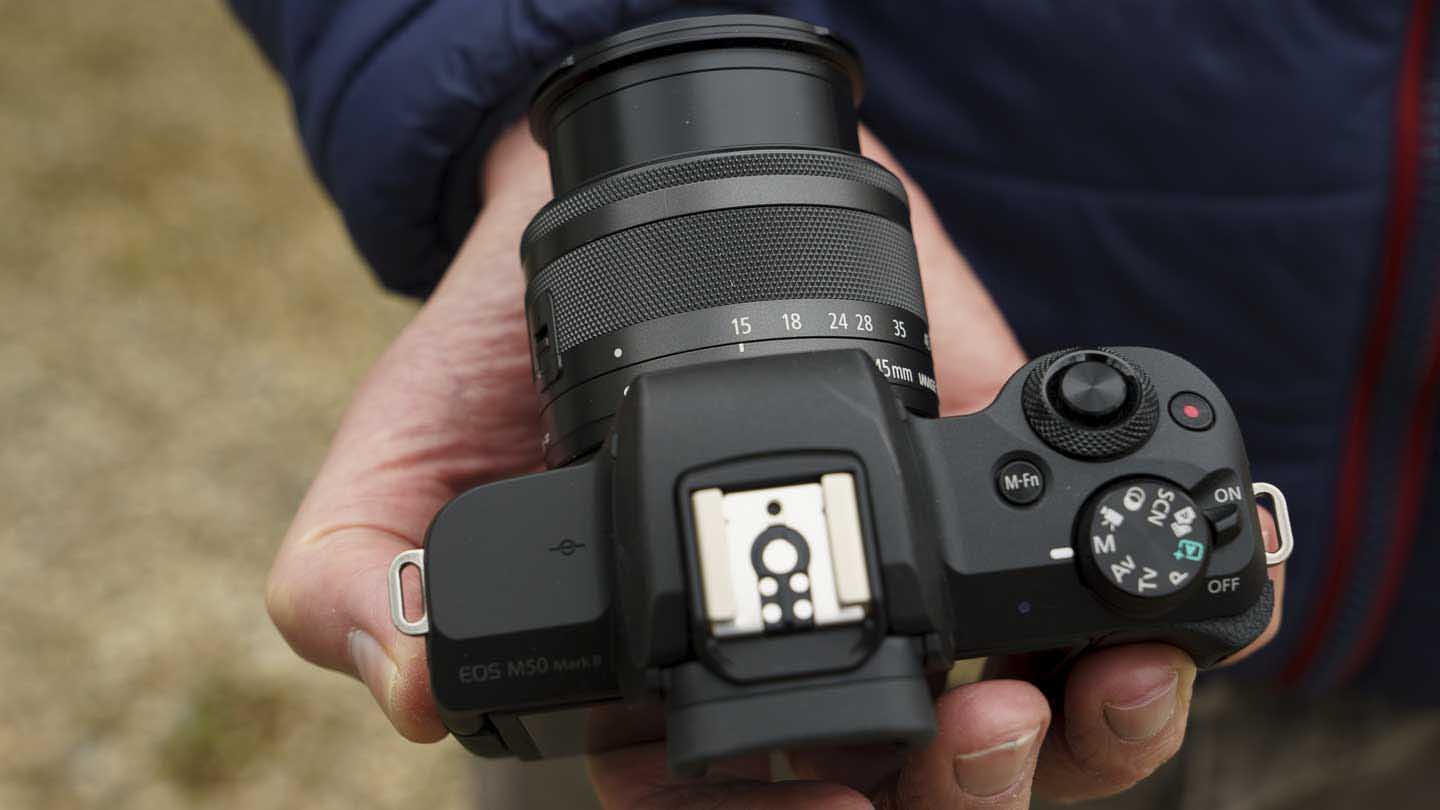The Canon EOS M50 Mark II is a mirrorless interchangeable lens camera with the Canon EF-M mount. It’s the replacement to the original EOS M50, but it actually makes a very modest upgrade by bringing the ability to stream live to a YouTube channel via a computer or smartphone with an internet connection, an enhanced autofocus system and the ability to shoot vertical video as well as in the more traditional landscape orientation.
Our Verdict
Like its predecessor, the Canon M50 Mark II is an attractively-sized, well-sculpted camera with a good-quality sensor, a responsive vari-angle touchscreen, a decent electronic viewfinder and a very-capable autofocus system. Unfortunately, that autofocus system can’t be used for shooting 4K video and there’s a 1.5x crop applied when that resolution is selected, which is a shame because the results are very good.
With the 15-45mm kit lens mounted and collapsed, the M50 II looks like a very tasty compact camera and its price is a little lower than the Canon PowerShot G7 X Mark III.
It’s also a nice camera to use provided that you’re comfortable with the limitations imposed on the 4K video capability and you’re happy to shoot raw to ensure that you get the best stills.
For
- Excellent image quality
- Superb implementation of touch-control
- Good-quality viewfinder built-in
Against
- 4K video mode crops the frame
- Limited lens range
What is the Canon EOS M50 Mark II?
Specification
- Camera type: Mirrorless
- Announced: USA: 14th October 2020, UK: 25th February 2021
- Sensor: 24.1Mp APS-C format (22.3 x 14.9mm) CMOS
- Processor: Digic 8
- Lens mount: Canon EF-M
- Sensitivity range: Stills: ISO 100-25,600 expandable to ISO 51,200, 4K Video: ISO 100-6400, Full HD & HD: ISO 100-12,800 expandable to ISO 25,600
- AF system: Dual Pixel CMOS phase detection with up to 3975 positions and 143 automatically selectable points
- Viewfinder: 0.39-type 2,360,000-dots OLED EVF
- Screen: Touch-sensitive vari-angle 3.0-inch LCD with 1,040,000 dots
- Video resolution: 4K (3840 x 2160) at 23.98, 25 fps Full HD: (1920 x 1080) at 59.94, 50, 29.97, 25, 23.976 fps), HD (1280 x 720) at 119.9, 100, 59.94, 50 fps
- Max continuous shooting rate: 10fps for up to 36Jpegs or 10 raw files
- Shutter speed range: 30-1/400 sec, Bulb
- Built-in flash: GN (ISO 100) 5
- Battery: Li-ion LP-E12, Viewfinder: Approx. 250 shots Live view: Approx 305 shots
- Dimensions (W x H x D): 116.3 x 88.1 x 58.7mm
- Weight: 387g (black), 390g (white) including battery and memory card
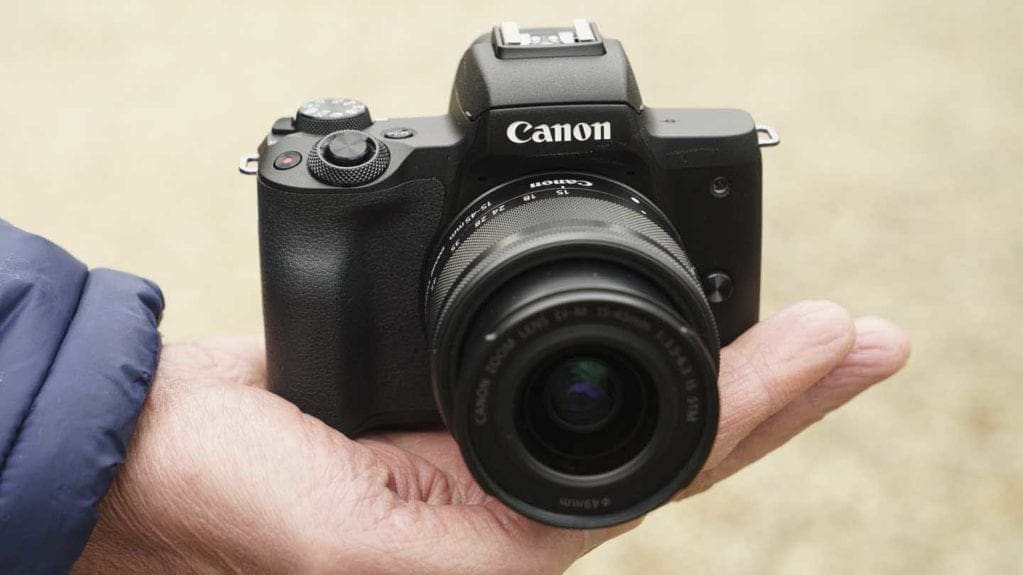
Features
Canon has used the same 24.1Mp APS-C format Dual Pixel AF CMOS sensor in the EOS M50 Mark II as is in the original M50 and it’s coupled with the same Digic 8 processing engine.
For stills, this combination enables a native sensitivity range of ISO 100-25,600, with expansion settings going up to ISO 51,200). If you’re shooting 4K video the available sensitivity range drops to ISO 100-6,400, but for Full-HD and HD movies, it’s ISO 100-12,800 (expandable to 25,600).
As it has the same sensor as the M50, the Canon M50 II has the same phase-detection autofocus system. According to Canon, there are up to 3975 selectable positions for the AF point and 143 automatically selectable points.
In an upgrade to the M50, the M50 II’s Eye AF that can be activated in Face + Tracking mode works when shooting video or stills.
On the subject of video, while the Canon M50 II is capable of shooting 4K (3840 x 2160) video, there are a couple of limitations. Firstly, there’s a 1.5x crop applied to the framing – that’s in addition to the 1.6x focal length magnification that results from the APS-C format sensor.
Consequently, the 15-45mm kit lens effectively becomes a 38.4-115.2mm optic, which is a bit long if you want to video yourself with the camera at arm’s length. If you’re planning on doing a lot of vlogging, you may want to invest in the EF-M 11-22mm f/3.5-5.6 IS STM.
Also, the autofocus system switches to contrast detection rather than the phase-detection system that is used for stills and Full-HD shooting.
Like the M50, the M50 II has a maximum continuous shooting rate of 10fps (frames per second) which can be maintained for up to 36 jpegs or 10 raw files. However, that’s n Single AF mode (S-AF), which means it’s only useful when the subject distance doesn’t change. If you need continuous focusing (C-AF) the maxim shooting rate drops to 7.4fps for up to 47 Jpegs.
Canon has given the M50 II a 3.5mm mic port and there’s both Wi-Fi and Bluetooth connectivity.
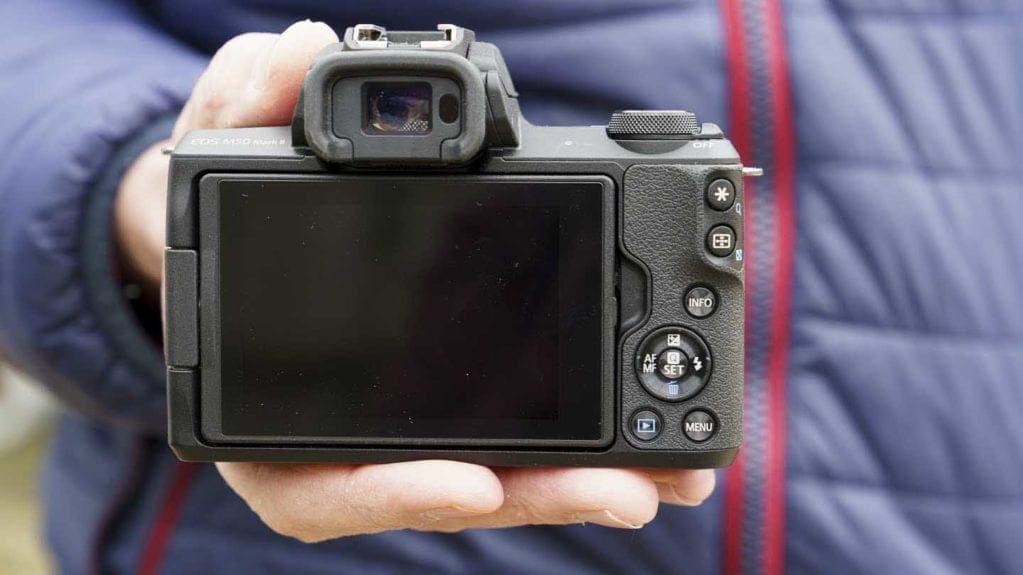
Build and Handling
Although the Canon M50 II has the same build and design as the M50, the first thing that strikes me about it is how compact it is in comparison to some other APS-C format mirrorless cameras. And of course, it’s a heck of a lot smaller than the Canon EOS R5 and EOS R6, the company’s most recent full-frame mirrorless cameras.
It’s small and light, yet the grip is well-shaped and has a nicely textured surface so it feels comfortable and secure in your hand. I took the M50 II on several long walks during my testing and I never bothered to fit a strap to it, I either popped it in a small bag or carried it in my hand.
Its small size, combined with a decent sensor and the vari-angle screen, is one of the main reasons that the M50 was so popular with vloggers. With the 15-45mm kit lens mounted, it’s light enough to hold at arm’s length for quite long periods of time.
I find that with my three middle fingers behind the body, my little finger on one side of the lens, my thumb on the other and the screen flipped out to the side to let me check my framing, I can keep the camera nice and steady.
The only issue, of course, is that my arm isn’t long enough to make shooting in 4K an appealing proposition because my face is framed too tightly. That makes Full HD shooting the best choice unless you invest in a wider lens.
Although it’s nicely shaped and there’s quick access to the key controls, the M50 II feels rather plasticky and if you tap it with your fingernail, it doesn’t sound especially solid. But to be fair, it’s also a sub-£600/$600 camera and sub-£700/$700 with the 15-45mm kit lens.

Control Layout
Just like the M50, the M50 Mark II’s control arrangement is like a mix of the Canon EOS M6 Mark II’s and a compact camera like the PowerShot G5 X Mark III.
There’s a mode dial on the top-plate with options such as program, shutter priority, aperture priority, manual and scene modes as well as Hybrid Auto, a Creative Filter and video mode.
Unlike the M6 II, however, the M50 II only has one control dial and unlike the G5 X Mark III, there isn’t a dedicated exposure compensation dial. If you want to adjust exposure compensation, you either have to tap that icon on the screen, or press the up navigation key and then use the control dial. In manual exposure mode, you can either tap on the exposure setting that you want to adjust or press the up key.
When an exposure control such as shutter speed is selected, you can adjust the value using either the touchscreen or the control dial. It’s pretty quick, but dual dial control would be faster.
One issue I spotted early on that you need to watch out for is that the left navigation key is set to switch between auto and manual focus by default. If you press it accidentally, the camera will be in manual focus mode when you expect to focus automatically.
Screen and viewfinder
As I’ve already mentioned, the 3-inch 1,040,000-dot screen on the back of the M50 II is touch-sensitive and thanks to its vari-angle hinge, it can be flipped and twisted to give a clear view whatever angle you’re shooting from.
Canon’s implementation of touch-control is excellent and you can navigate the menu or make setting selections with taps on the screen as well as set the AF point. If Touch and Drag AF is enabled in the menu, the AF point can be set with your thumb on the screen while you’re looking through the viewfinder. This works especially well when the screen is flipped to the side of the camera as there’s little risk that your nose will touch the screen. If you prefer to keep the screen against the back of the camera, you might want to consider limiting the Touch and Drag area to a specific part of the screen.
Crucially, the screen is very responsive.
A 0.39-inch type viewfinder is pretty standard for an APS-C format camera and the 2,360,000-dot resolution of the OLED gives a clear view. It’s particularly useful when your subject is moving or you’re shooting in bright sunshine.
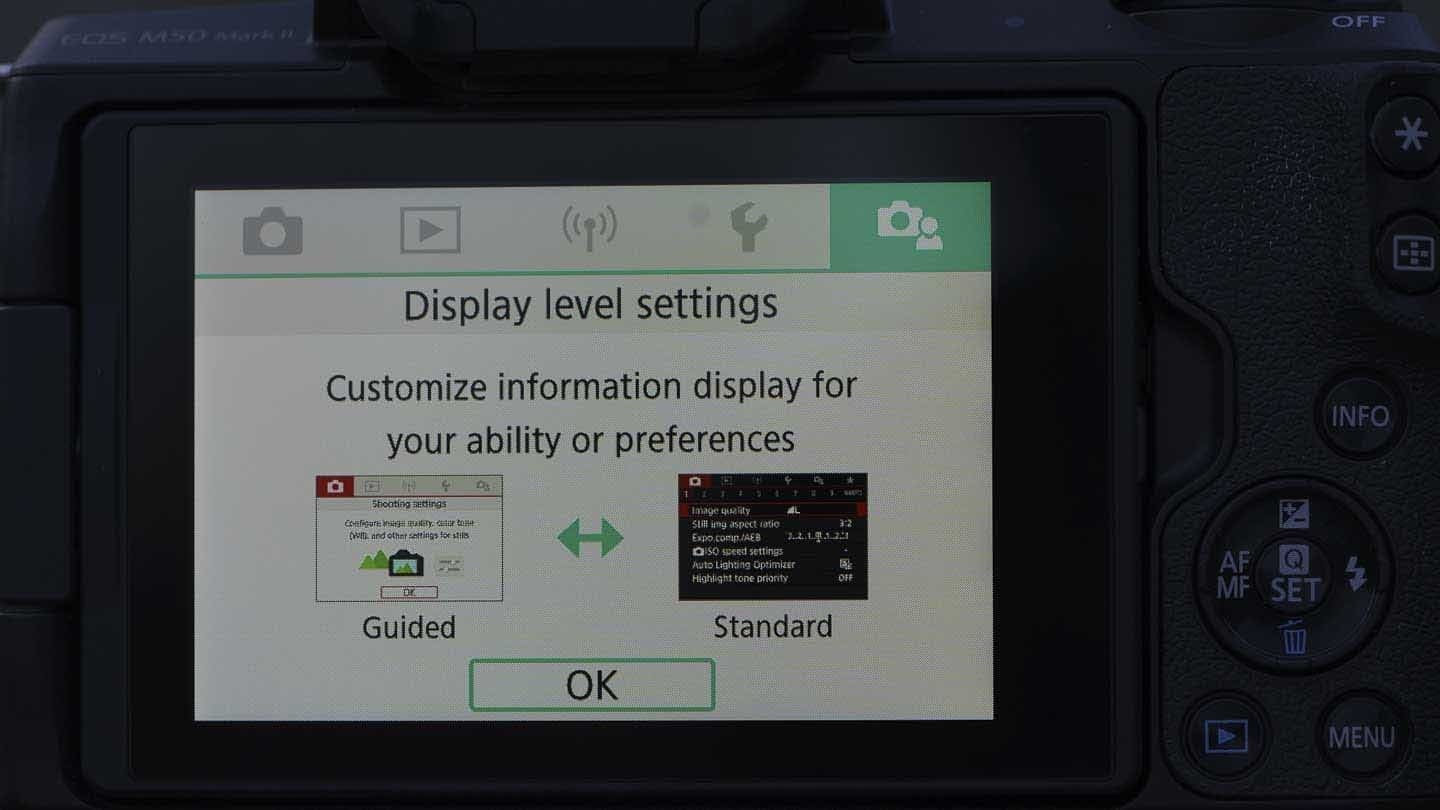
Interface
There’s a choice of two interface modes available on the M50 II, Guided and Standard.
Guided mode is the default setting and it’s useful if you’re new to photography, but more experienced photographers are likely to want to opt for Standard mode.
Streaming to YouTube with the Canon EOS M50 Mark II
Streaming live to YouTube isn’t quite as simple as tapping the appropriate icon on the camera and inputting your YouTube channel’s details, there are a few more steps than that. Also, if you want to stream via a mobile phone, your YouTube channel needs to have at least 1000 subscribers and live streaming needs to be enabled. Understandably, the phone must also have an internet connection with a speed of at least 6Mbps.
With those criteria satisfied, the first step is to tap on ‘Wi-Fi/Bluetooth connection’ in the camera’s menu and create an image.canon account via the ‘Upload to Web Service’ option. The touchscreen is very helpful here because you can tap all the details in pretty quickly.
Once the account has been created, a new ‘Live Streaming’ option appears on the camera’s screen after you tap ‘Wi-Fi/Bluetooth connection’ in the menu.
Then you need to go to your YouTube channel on your computer or your paired smartphone and select ‘Go Live’ to create a live event. Then you’re ready to go back to ‘Wi-Fi/Bluetooth connection’ on the camera, select ‘Live Streaming’ and follow the steps.
I was able to get streaming quickly via my computer, but it was a different story when I tried to connect via my iPhone. The camera could see the live event that I created, but every time I tried to connect, I got a server error. After trying more than a dozen times, I switched back to using the computer, but this time, that didn’t work either. In the end, I gave up.
Shooting Vertical Movies with the Canon EOS M50 Mark II
In order for the playback device, for example, a smartphone, to show a video in the correct orientation, vertical format video needs to be tagged with the orientation or rotation data. The Canon M50 Mark II can tag the video files automatically provided the option is selected via the menu.
This is simple to set up, just go to the first tab of the Function settings menu and scroll down to ‘Add rotate info’, select it and then set it to ‘Enable’.
Whatever orientation you shoot the video in, and whatever the ‘Add rotate info’ setting, the M50 II plays video in horizontal orientation, which could cause confusion.
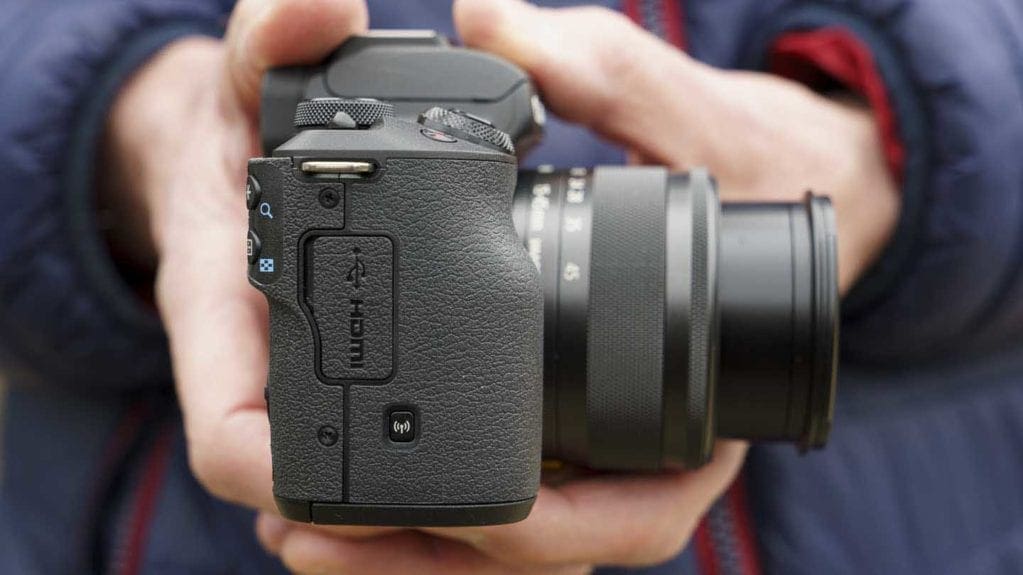
Performance
In its default settings, the Canon M50 II can do a good job and capture attractive images. Its auto white balance setting is pretty dependable and normally captures appealing images that reflect the atmosphere of the scene while the Evaluative metering system delivers nicely-balanced exposures in many situations.
Helpfully, the M50 II’s electronic viewfinder and main screen also give a pretty good preview of the scene with all the camera settings applied, so you usually know what you’re doing to get before you press the shutter release.
Image Quality
There are no major surprises with the Canon EOS M50 Mark II, its raw files deliver what you expect from a decent 24Mp APS-C format sensor and there’s a good level of detail visible at low-sensitivity (ISO) settings.
Noise is controlled well up to around ISO 3200 and by ISO 6400 there’s a fine-grained texture visible in raw and Jpeg files at normal viewing sizes. As you’d expect, the noise is less visible in Jpegs than it is in simultaneously captured raw files, but it’s good to see that Canon doesn’t completely smooth it all out as many Jpegs still have a respectable level of detail visible.
As usual, it’s best to avoid the expansion settings and if possible stick to ISO 12,800 or lower.
However, in some situations, the M50 Mark II’s raw files look quite different from its simultaneously captured Jpegs. The lawn around a local churchyard in an ISo 320 shot, for example, has a lot more detail in the raw file than in the Jpeg where it is almost reduced to a wash of colour.
On some occasions, the M50 Mark II’s Jpegs look more attractive than raw files, which seem very flat by comparison. This can be addressed by a slight boost to the raw image’s vibrancy, and perhaps a little darkening of the blacks, giving the image a bit more pep without the local contrast boost that can make the Jpeg files appear a little less natural.
Autofocus
Canon’s Dual Pixel sensor design means that the M50 II has phase-detection autofocusing, and it works very well. It’s fast and accurate and can keep up with fast-moving subjects.
The Face Detection + Tracking is also very good and when the Eye AF focusing is activated, it’s quick to spot eyes in the frame even when the subject is wearing spectacles.
Unfortunately, the M50 II can’t use phase-detection focusing for video when the resolution is set to 4K. The contrast-detection focusing is reasonably good, but it can be more indecisive than the phase-detection system, especially when levels drop.
Video Performance
Putting aside the limitations applied to 4K recording, the Canon M50 Mark II is capable of recording attractive, high-quality footage. The video colours, white balance and exposure match those of the stills.
In the absence of in-body stabilisation, the camera uses lens-based stabilisation or Digital IS. This works reasonably well, but you need to be careful when you’re shooting and small gimbal like the Zhiyun Weebill S can make a big difference.
Canon EOS M50 Mark II Sample Images
Follow the link to browse and download full-resolution images from the Canon EOS M50 Mark II.
Canon EOS M50 Mark II Image Gallery

Canon EOS M50 Mark II Sample Video
This video was shot on the Canon EOS M50 Mark II set to 4K (3840×2160) 25fps with the white balance set to Daylight – it’s straight from the camera with no grading. It was shot using the EF-M 15-45mm f/3.5-6.3 IS STM with the stabilisation on.
Shooting in 4K mode means that the M50 II uses contrast-detection focusing, and for the most part, it performed well, but there are a couple of occasions in the footage where the camera loses the subject.
The Daylight white balance setting is really designed for sunny conditions and the video looks much better when the sun is out. As a rule, it’s best to change the white balance with the light.
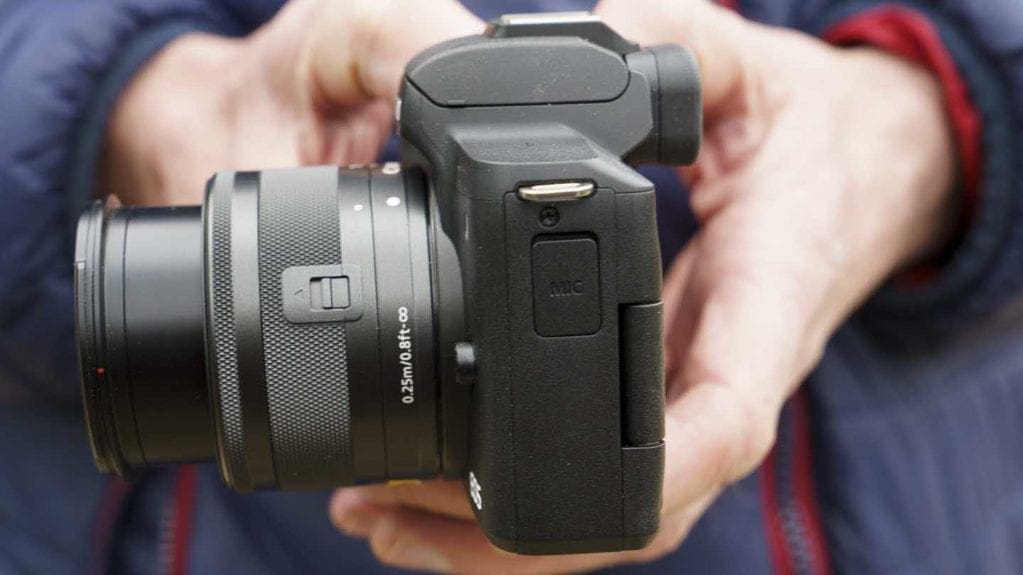
Verdict
The Canon EOS M50 Mark II is rather puzzling. It has several attractive features, such as a vari-angle screen with very responsive touch-sensitivity, two versions of a well-thought interface, a good-quality electronic viewfinder and a decent sensor inside a wonderfully compact body. It ticks a lot of boxes. But all of those boxes are also ticked by the original EOS M50, and the Mark II camera doesn’t address the major criticisms of the original camera – the limitations applied to 4K video recording.
What’s more, the upgrades that the M50 Mark II makes on the M50 could have been made by a firmware upgrade.
Clearly, nobody is going to upgrade their M50 for the M50 Mark II through choice, but the new camera still has plenty of appeal for first-time buyers. It’s also fairly competitively priced in comparison to the likes of the Fujifilm X-T200 and Panasonic G100, and even the compact Canon PowerShot G7 X Mark III.
My main concern with the Canon EOS M50 Mark II is Canon’s seeming lack of enthusiasm for making EF-M lenses. Take a look at the company’s website and you’ll see that there are only nine EF-M lenses listed. Also, while they are attractively small, none of the zooms have a constant maximum aperture. I question Canon’s seriousness about the mount and the future of the EOS M line.
